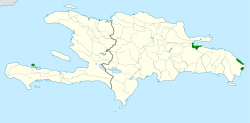| Ridgway's hawk | |
|---|---|
 | |
| In Los Haitises National Park, Dominican Republic | |
| Scientific classification | |
| Kingdom: | Animalia |
| Phylum: | Chordata |
| Class: | Aves |
| Order: | Accipitriformes |
| Family: | Accipitridae |
| Genus: | Buteo |
| Species: | B. ridgwayi |
| Binomial name | |
| Buteo ridgwayi (Cory, 1883) | |
 | |
| Range in green | |
| Synonyms | |
Rupornis ridgwayi | |
Ridgway's hawk (Buteo ridgwayi) is a bird of prey in the family Accipitridae endemic to the island of Hispaniola (both Haiti and the Dominican Republic) in the Caribbean. It is classified as Critically Endangered because of habitat destruction and human persecution in the Dominican Republic; however, due to conservation efforts, the population is now increasing. [1]
Contents
It is named in honour of the ornithologist Robert Ridgway.
